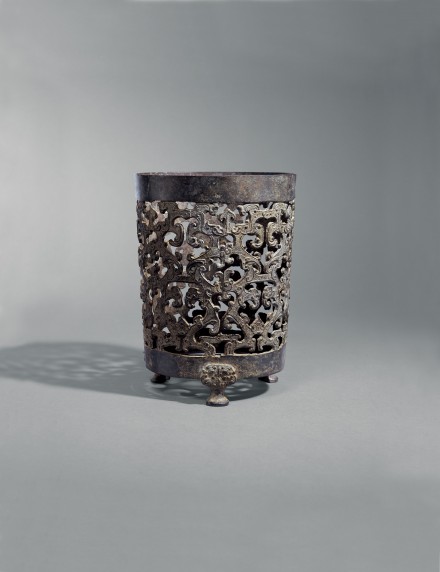J.J. Lally & Co., Oriental Art / New York City, New York
MenuPast Exhibition
Arts of Ancient China
March 27 - April 12, 2006

13.
AN ARCHAIC BRONZE OPENWORK TRIPOD INCENSE BURNER
OR PERFUMER (LIAN)
Warring States Period, late 5th-early 4th Century B.C.
of slightly flaring cylindrical form, the thinly cast openwork sides, decorated with interlaced 'dragon-cloud' strapwork which is embellished on the exterior with fine striated spiral and scroll motifs all over, the raised borders of the interlocking bands turning into hooks, scrolls and stylized wings cast in varied relief throughout the pattern which is repeated in six vertical segments between plain bands encircling the mouth and the foot, the base with an openwork quatrefoil whorl-form plate decorated with granulation on the upper surface and supported on three narrow ledges formed by the top of the three short half-round pad feet evenly spaced around the bottom rim, each emerging from a small inverted taotie mask with large almond-shaped eyes, cast with scale pattern and scroll-form elements in varied relief to show the horns, eyebrows, nose and upper jaw, the surface of the vessel with a thin olive-brown patina, showing remains of lighter tan earth from burial.
Height 5 7⁄8 inches (15 cm)
The technique of openwork bronze casting combined with finely detailed and elaborate decoration was highly developed in the ancient state of Chu. Compare the similar bronze openwork tripod vessel discovered in 1985 in a Chu burial site at Baoshan, Jingmen County, Hubei province illustrated in Zhongguo Qingtongqi Quanji (Compendium of Chinese Bronzes), Vol. 10, Eastern Zhou (4), Beijing, 1998, p. 79, no. 79.
Another bronze openwork tripod vessel of this type was excavated in 1957 from Xiaoliu village, north of Changtai Pass, Xinyang, Henan province, illustrated by Tregear in Arts of China, Neolithic Cultures to the T’ang Dynasty – Recent Discoveries, Tokyo, 1968, p. 51, no. 81, with description on p. 212, where the author suggests that the vessel “…appears to be a brazier of some sort.” The same vessel is illustrated by So in Eastern Zhou Ritual Bronzes from the Arthur M. Sackler Collections, Washington D.C., 1995, p.387, in two views, together with a detailed line drawing, described in the caption as an incense burner.
A related openwork bronze vessel, excavated in 1965 from a Chu tomb, identified as Wangshan no. 1, at Jiangling, Hubei, is illustrated in Wenwu, 1966, No. 5, fig. 9, p. 37. Remains of plants were found inside the vessel which was wrapped with silk, suggesting that perhaps it was used as a perfumer.
戰國時期 透雕龍雲紋薰 高 15 厘米
13.
AN ARCHAIC BRONZE OPENWORK TRIPOD INCENSE BURNER
OR PERFUMER (LIAN)
Warring States Period, late 5th-early 4th Century B.C.
Height 5 7⁄8 inches (15 cm)